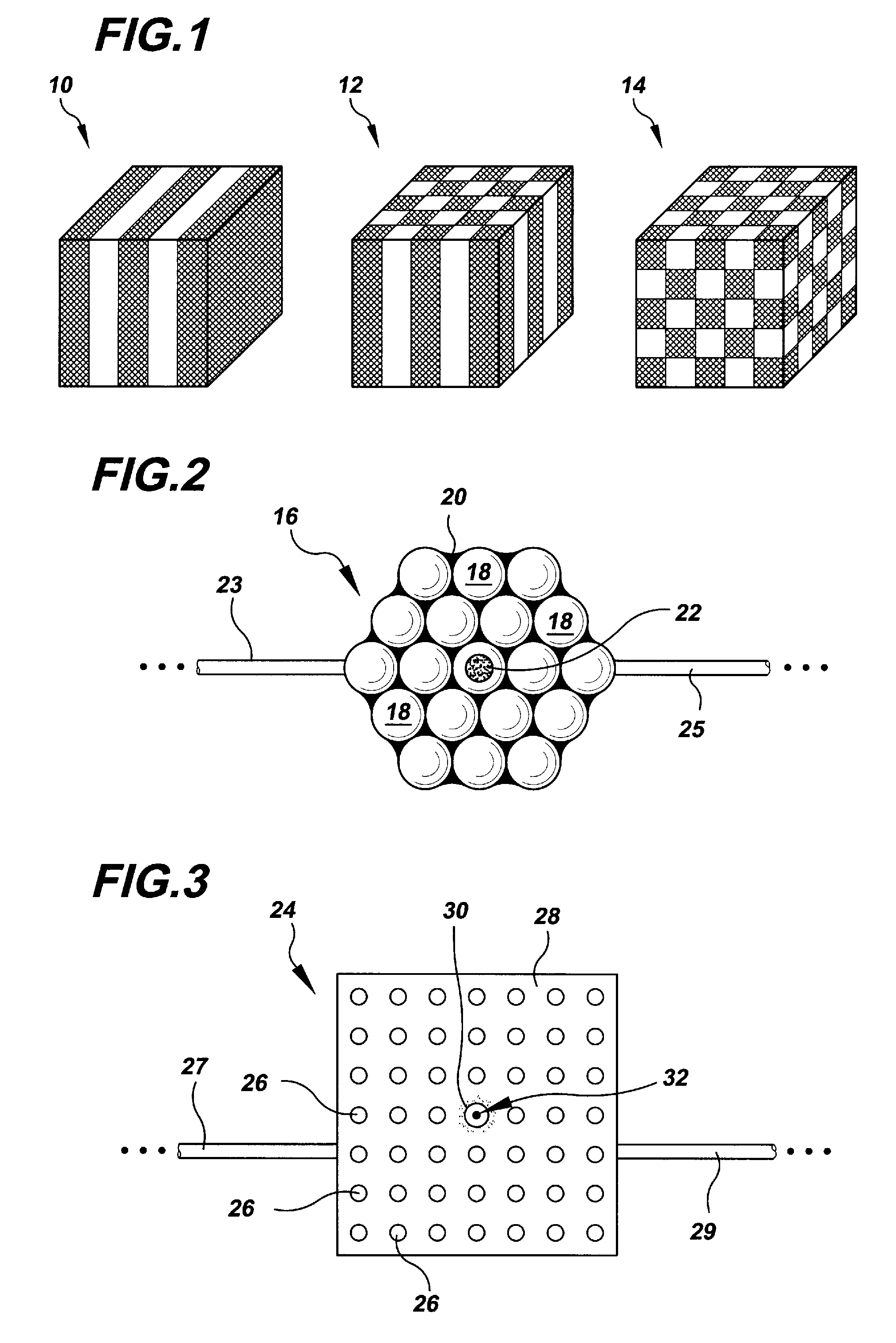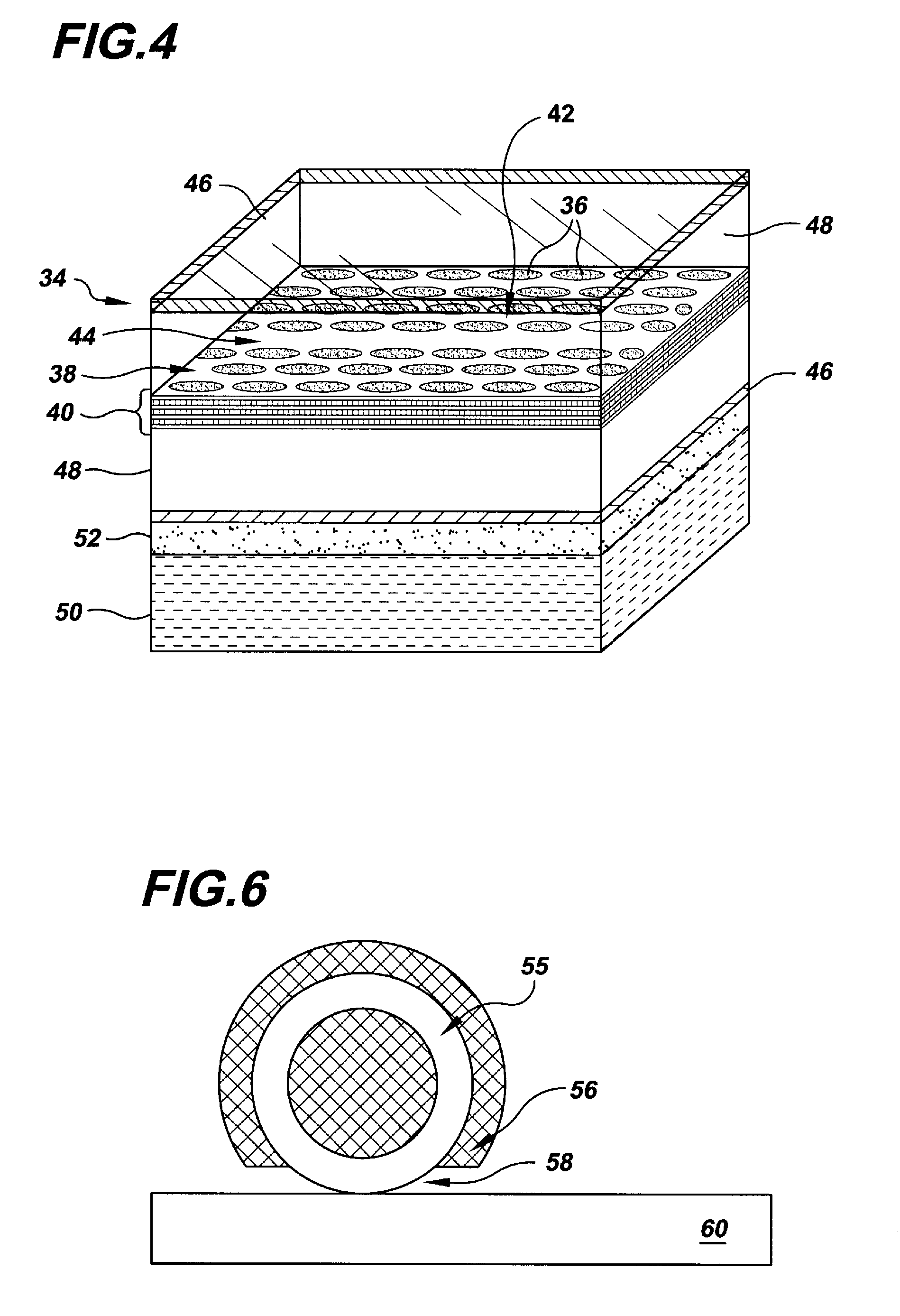Optical Devices Having Controlled Nonlinearity
a technology of optical devices and nonlinearities, applied in the field of optical devices, can solve the problems of increasing the characteristic quality factor of the device, and reducing the performance of the device, so as to achieve the effect of improving the device performan
- Summary
- Abstract
- Description
- Claims
- Application Information
AI Technical Summary
Benefits of technology
Problems solved by technology
Method used
Image
Examples
first example class
dielectric environments to be employed in accordance with the invention is the class of photonic crystals. A photonic crystal is a dielectric structure having a periodic, i.e., repeating, arrangement of alternating high-dielectric and low-dielectric regions. With sufficient index contrast and appropriate lattice structure, e.g., face-centered cubic arrangement of dielectric regions, a photonic band gap is produced in the photonic crystal. Propagation of light through the crystal within the photonic band gap is exponentially suppressed; in other words, a range of frequencies of light cannot propagate through the crystal, and that prohibited frequency range is characterized by the photonic band gap.
Conventionally, the periodicity of a photonic crystal lattice and the dimensions of the dielectric regions in the lattice are selected to suppress the propagation in the crystal of a selected incident wavelength for a given optical application. In accordance with the invention, the periodic...
example 1
The two-dimensional photonic crystal structure of FIG. 2 is analyzed for a two-dimensional triangular lattice of air holes in a dielectric medium of doped Si (ε=13). The nonlinear material provided at the center of the structure is provided as a GaAs—AlGaAs single quantum well. The periodicity of the photonic crystal is 331 nm, and the radius of the air holes is 158 nm.
FIG. 7A is a plot of the relative enhancement of the TM local density of states for the structure, as-measured in the time-domain simulation rate of emission, Γ, normalized by the emission rate in vacuum, Γo. Inside the photonic band gap of the structure, there is substantial but slightly incomplete suppression of emission. Outside the band gap, there is an enhancement of spontaneous emission because the density of states of the nonlinear material is shifted to frequencies surrounding the band gap. For an atom polarized in the direction out of the two-dimensional plane of the crystal, only the TM polarization need be ...
example 2
The two-dimensional photonic crystal structure of FIG. 3 is analyzed for a 7×7 square lattice of dielectric rods of Si, having ε=12.25, with a radius of 0.25α, where α is the period of the lattice. The rods are surrounded by air. The middle defect site is provided with a radius of 0.35α. A nonlinear material, namely, a CdSe nanocrystal, is provided at the defect site.
FIG. 8A is a plot of a numerical calculation of the enhancement of spontaneous emission for the structure, given as the ratio of the rate of emission of the nonlinear material in the photonic crystal, T1, purcell−1, divided by the emission rate in vacuum, T1,vac−1, as a function of frequency.
Given a value of T2≈0.13 fs at room temperature for a CdSe nanocrystal at the defect site, there is determined the enhancement, η, of the real part of the Kerr nonlinear susceptibility, χ(3), in the structure of FIG. 3, as a function of electronic transition frequency, ωelec, when probed at a frequency, ωph=0.508(2πc / a), the cavity'...
PUM
| Property | Measurement | Unit |
|---|---|---|
| temperature | aaaaa | aaaaa |
| electronic band gap | aaaaa | aaaaa |
| speed | aaaaa | aaaaa |
Abstract
Description
Claims
Application Information
 Login to View More
Login to View More - R&D
- Intellectual Property
- Life Sciences
- Materials
- Tech Scout
- Unparalleled Data Quality
- Higher Quality Content
- 60% Fewer Hallucinations
Browse by: Latest US Patents, China's latest patents, Technical Efficacy Thesaurus, Application Domain, Technology Topic, Popular Technical Reports.
© 2025 PatSnap. All rights reserved.Legal|Privacy policy|Modern Slavery Act Transparency Statement|Sitemap|About US| Contact US: help@patsnap.com



